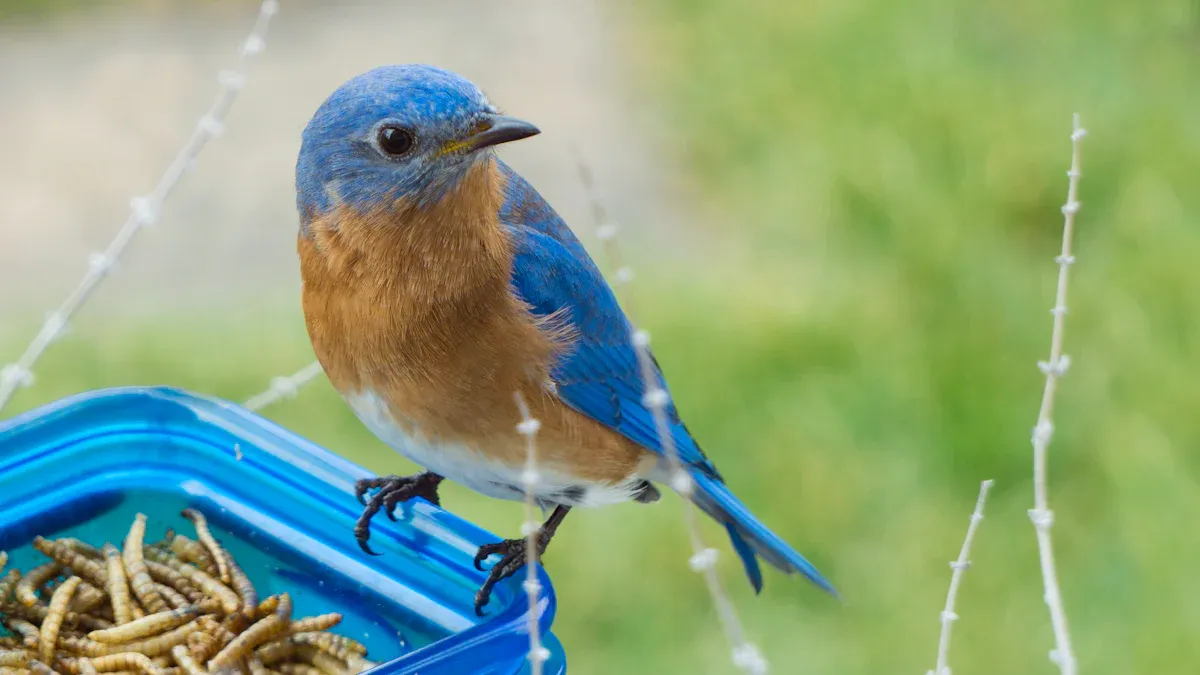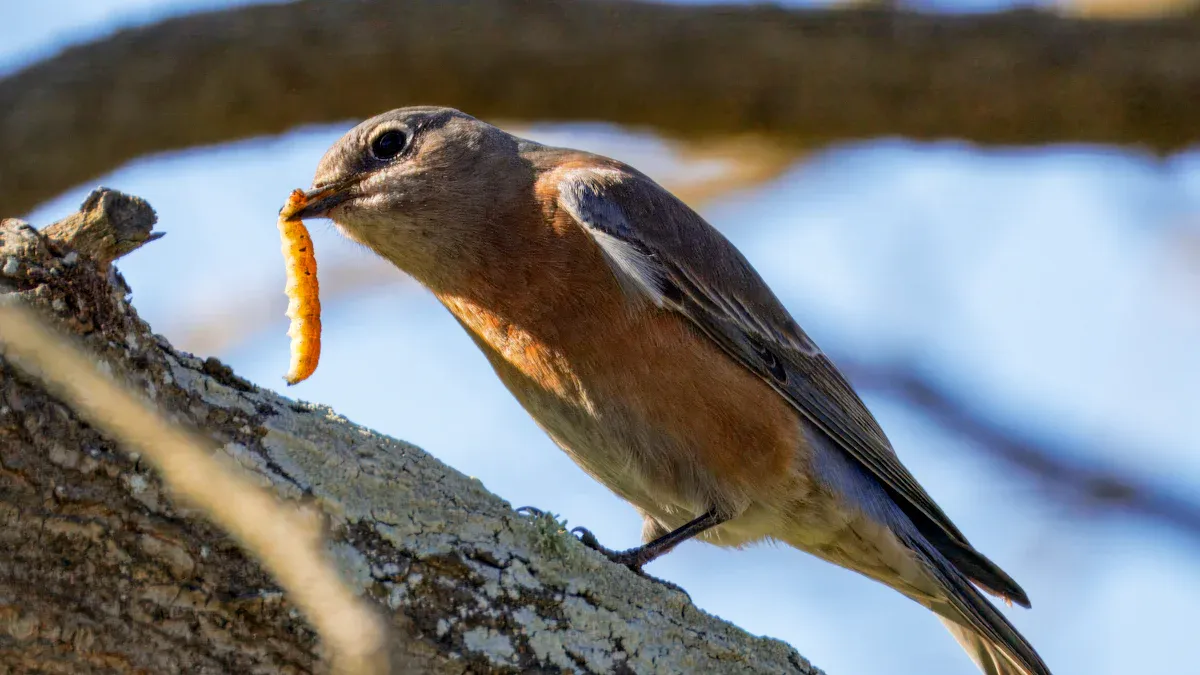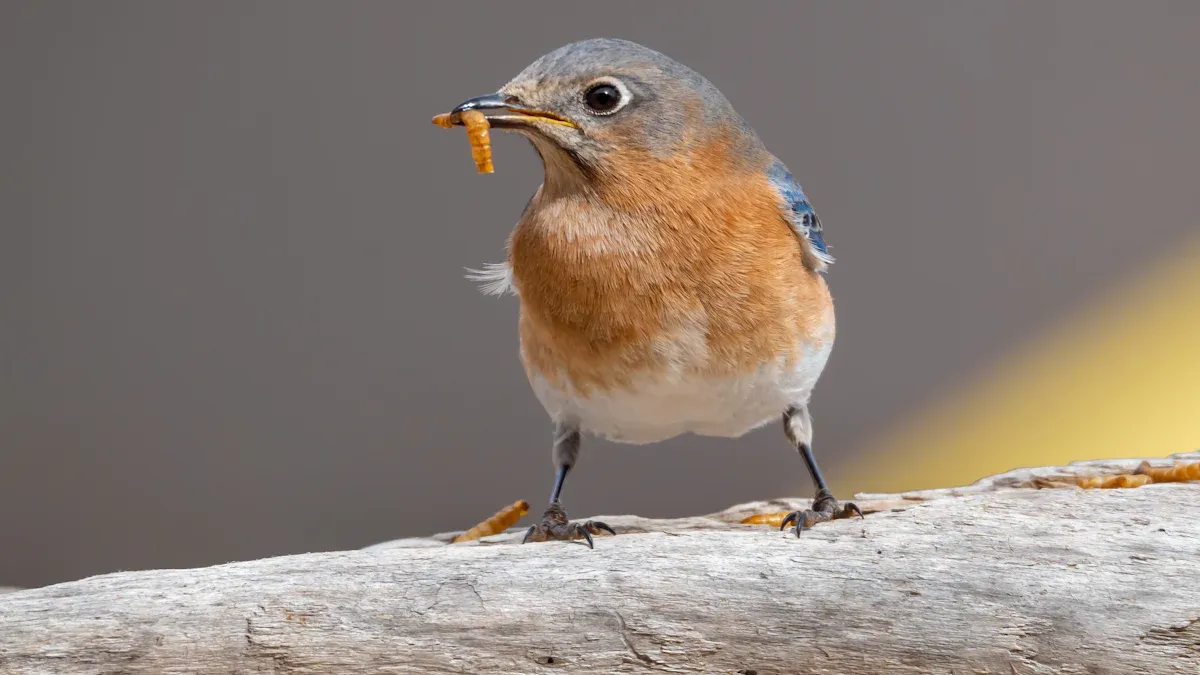
Bird enthusiasts often look for the best way to feed their feathered friends. Dried mealworms for birds are a game-changer. They pack a punch with nutrients, making them a reliable food source. Handling them is a breeze, and they attract a rainbow of bird species. Robins, bluebirds, and chickadees will thank you for it!
キーテイクアウト
- 乾燥ミールワームは full of protein, fat, and fiber. They are a healthy food for birds. They give energy, especially during migration and breeding times.
- These mealworms are simple to store and use. They don’t need special care like live bugs. They last a long time, so birds can eat them all year.
- Dried mealworms bring many bird types, like robins and bluebirds. Adding them to other bird food makes meals healthier and attracts more birds.
鳥の乾燥食虫の栄養的利点

High in Protein, Fat, and Fiber
Dried mealworms are a powerhouse of nutrition. They are packed with approximately 45% protein and 33% fats, making them an excellent energy source for birds. Protein helps birds build strong muscles and feathers, while fats provide the fuel they need for daily activities. Fiber, though present in smaller amounts, supports digestion and keeps their systems running smoothly.
Birds like robins, bluebirds, and chickadees thrive on this nutrient-rich food. Whether they’re preparing for migration or raising their young, dried mealworms for birds deliver the essential nutrients they need to stay healthy and active.
Essential for Birds’ Energy and Health
Birds expend a lot of energy flying, foraging, and staying warm during colder months. Dried mealworms provide the perfect boost. Their high protein and fat content are especially beneficial for endurance flights and harsh weather conditions. Studies show that these nutrients are vital for maintaining energy levels in birds like European starlings.
By offering dried mealworms, bird enthusiasts can ensure their feathered visitors get the nutrition they need. This is particularly important during breeding and migration seasons when birds require extra energy.
Suitable for All Seasons and Bird Species
One of the best things about dried mealworms is their versatility. They are suitable for feeding birds year-round. In spring and summer, they help birds during nesting and chick-rearing. In fall and winter, they provide much-needed energy to survive the cold.
Dried mealworms for birds attract a wide variety of species, from colorful cardinals to curious woodpeckers. Even robins, known for their picky eating habits, can’t resist these protein-packed treats. Adding dried mealworms to your garden ensures you’ll see a diverse range of birds throughout the year.
Convenience and Practicality
Easy to Store and Handle
Dried mealworms are incredibly easy to store and handle, making them a favorite among bird enthusiasts. Unlike live insects, they don’t require special care or maintenance. There’s no need to worry about keeping them alive or providing the right environment. Simply store them in a cool, dry place, and they’ll stay fresh and ready to use.
Live insects, such as black soldier flies or mealworm beetles, often need specific conditions to thrive. They require controlled temperatures and humidity levels, which can be challenging to maintain. Dried mealworms eliminate these hassles. They offer all the benefits of live insects without the extra effort.
For those who find handling live insects unpleasant, dried mealworms provide a perfect alternative. They contain all the protein birds need, without the wriggle!
Long Shelf Life and Year-Round Availability
One of the biggest advantages of dried mealworms is their long shelf life. They can be stored for months without losing their nutritional value. This makes them a reliable food source, especially during seasons when live insects are scarce.
Bird enthusiasts can stock up on dried mealworms for birds and enjoy the convenience of having them available year-round. Whether it’s the heat of summer or the chill of winter, these mealworms remain fresh and ready to feed.
Their availability throughout the year ensures that birds always have access to a protein-rich diet. This is particularly important during winter when natural food sources are limited. By offering dried mealworms, bird lovers can support their feathered friends no matter the season.
Perfect for Bird Enthusiasts and Beginners
Dried mealworms are a fantastic choice for both seasoned bird enthusiasts and beginners. They’re simple to use and require no special skills or equipment. Just sprinkle them in a feeder or mix them with other bird feeds, and watch the birds flock to your garden.
Beginners often find live insects intimidating to handle. Dried mealworms remove that barrier, making bird feeding accessible to everyone. They’re clean, easy to manage, and attract a wide variety of bird species. From colorful cardinals to curious woodpeckers, these mealworms bring life and color to any backyard.
For experienced bird watchers, dried mealworms offer a dependable and versatile feeding option. They can be used in various feeders and combined with other foods to create a diverse menu for birds. Whether you’re a novice or a pro, dried mealworms make bird feeding a delightful experience.
Safety and Hygiene Advantages
Reduced Risk of Contamination and Pests
Feeding birds with dried mealworms significantly reduces the risk of contamination and pests. Live insects can carry bacteria or parasites that may harm both birds and humans. Dried mealworms, on the other hand, undergo a drying process that eliminates these risks. This makes them a safer option for your backyard visitors.
The European Food Safety Authority (EFSA) has confirmed that edible mealworms are safe for consumption. Their evaluation included allergen risks and a 90-day toxicity study, which found no safety concerns. This research highlights dried mealworms as a cleaner and healthier alternative to live insects.
No Need to Handle Live Insects
Handling live insects can be unpleasant for many bird enthusiasts. Dried mealworms solve this problem. They offer all the nutritional benefits of live insects without the hassle of dealing with wriggling bugs. Simply scoop and serve—no gloves or bravery required!
This convenience makes dried mealworms for birds an excellent choice for beginners and seasoned bird watchers alike. Even those who are squeamish about insects can enjoy feeding their feathered friends.
A Cleaner and Safer Feeding Option
Dried mealworms provide a cleaner feeding experience. They don’t leave behind messy residue or attract unwanted pests like ants or flies. Unlike live insects, they won’t escape or create a mess in your storage area.
By choosing dried mealworms, bird lovers can maintain a hygienic feeding station. This ensures a safe environment for both birds and humans, making bird feeding a more enjoyable activity.
Versatility in Bird Feeding

Compatible with Various Feeders
Dried mealworms fit perfectly into different types of bird feeders, making them a versatile choice for bird enthusiasts. Whether you use a tray feeder, a hanging feeder, or even a ground feeder, these mealworms work well in all setups. Birds like wrens, bluebirds, and robins eagerly flock to feeders offering dried mealworms.
Wrens, Grosbeaks, Warblers, Bluebirds, Mockingbirds, Robins, and Brown Thrashers, who are all insect-eating birds, will appreciate a dish of mealworms. Although fresh is best, they will not snub dried mealworms added to seed mixes.
This compatibility allows bird lovers to experiment with different feeder types and attract a diverse range of species to their gardens.
Can Be Mixed with Other Bird Feeds
Dried mealworms for birds can easily be combined with other feeds to create a balanced and nutritious diet. Mixing them with seeds, suet, or fruit enhances the overall nutritional value and appeals to a wider variety of birds. Studies show that adding mealworms to feed improves growth performance and nutrient digestibility in animals.
| Study | Mealworm Inclusion (g/kg) | Key Findings |
|---|---|---|
| Biasatu et al. | 50, 100, 150 | Increased body weight and daily gain with higher mealworm levels. |
| Ballitoc and Sun | 0 to 100 | Improved growth performance with mealworm supplementation. |
| Bovera et al. | 296 | Positive effects on broiler performance noted. |
| Jane et al. | N/A | Animal protein sources like mealworms have better nutrient digestibility. |
| Fink | N/A | High unsaturated fatty acids in mealworm maintain fat digestion when replacing soybean meal. |
This flexibility makes dried mealworms a great addition to any bird feeding routine.
Attracts a Wide Range of Bird Species
Dried mealworms are a magnet for a variety of bird species. From colorful cardinals to curious woodpeckers, these protein-packed treats appeal to birds of all shapes and sizes. Even picky eaters like robins enjoy them, earning the nickname “mealworm gourmet.”
Adding dried mealworms to your garden ensures visits from bluebirds, chickadees, nuthatches, and more. Their universal appeal makes them a must-have for bird enthusiasts looking to attract a diverse flock. With dried mealworms for birds, your backyard can become a lively haven for feathered friends year-round.
Dried mealworms for birds offer unmatched benefits. They’re nutritious, easy to handle, and attract a variety of species. Bird enthusiasts can rely on them as a year-round food source. By choosing dried mealworms, you’ll support your feathered friends’ health while enjoying a vibrant backyard filled with life and color.
🐦 ヒント: Robins, bluebirds, and chickadees especially love dried mealworms. Add them to your feeders today!
よくある質問
What types of birds enjoy dried mealworms?
Robins, bluebirds, chickadees, cardinals, and woodpeckers love them. Even picky eaters like wrens and nuthatches can’t resist these protein-packed treats.
乾燥食虫の保存方法は?
Keep them in a cool, dry place. A sealed container works best to maintain freshness and keep pests away.
Can dried mealworms replace live insects entirely?
Yes! They offer the same nutrition without the hassle of handling live bugs. Birds get all the protein they need, minus the wriggle.
🐦 ヒント: Mix dried mealworms with seeds or suet to attract even more bird species to your garden!


